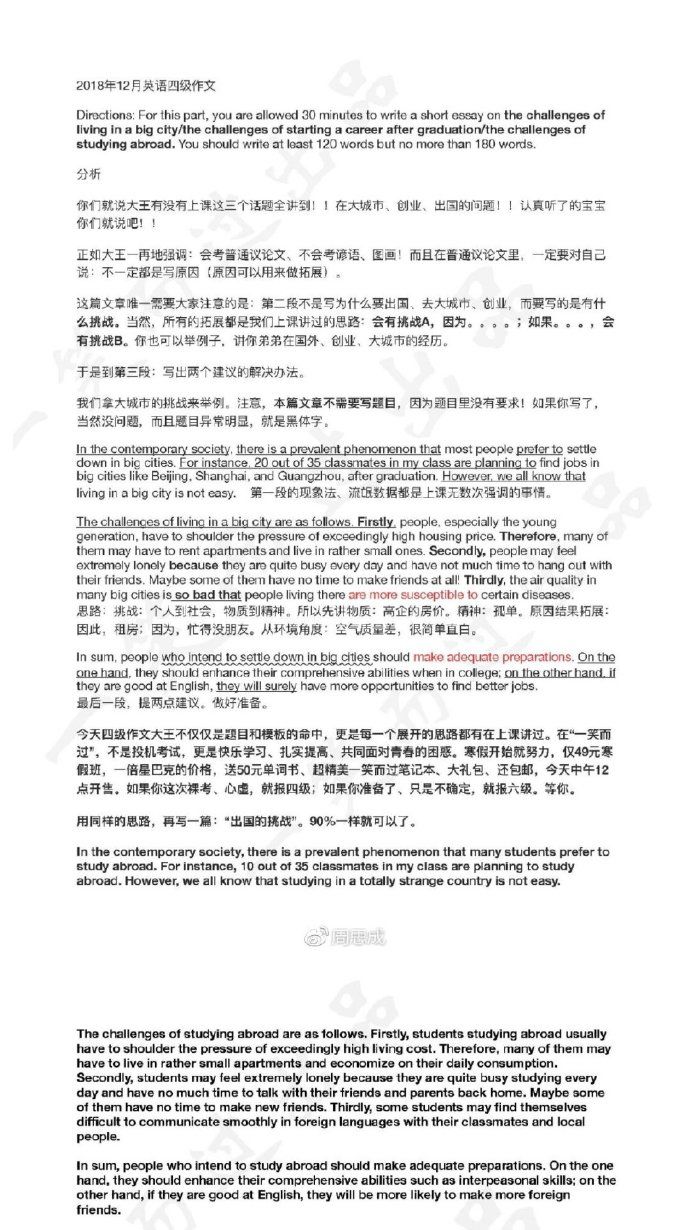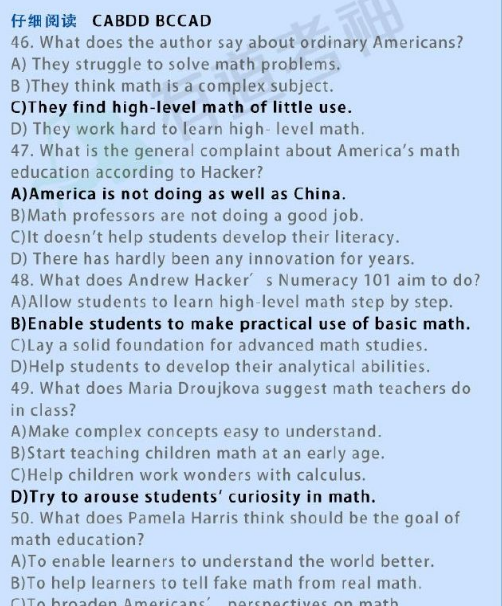中山大学2004年英语专业考研英美文学专业试卷
|
Entrance EXAM for 2004M. A- Program I. Explain briefly any 3 of the terms listed below (20%) II. Comment briefly on any 2 of the following characters. (20%) III. Match the literary work with the author. For each question (A-T) fill in the blank with one figure (1-20). (20%) A. The Portrait of a Lady 1. William Carlos Williams Part Two IV. A sonnet is a fourteen-line poem of iambic pentameter. It was originated in Italy in the 14th century and introduced to England by Thomas Wyatt and the Earl of Surrey. Since then it has been a form of poetry much favored by the English poets. William Shakespeare wrote 154 sonnets. However, the Shakepearean or English sonnet is different from the Italian. Explain the differences of the two kinds of sonnets. (30%) V. According to many critics, Francis Bacon is the father of the English essay while Charles Lamb, the Shakespeare of it. Make a comment on the statement (30%) VI. In what sense do you think that critical realism is a suitable label for the realistic novels in 19th century England? (30%) VII. How do you interpret the concept “the code heroes,” which refers to a certain group of characters created by Hemingway? Give examples to support your point (30%) VIII. The Adventures of Huckleberry Finn was praised by Hemingway as a book from which “all modern American literature comes.” How do you interpret Hemingway’s comment? (30%) IX. Give a brief introduction to one of your favorite writers in British or American literature (30%) I.Explain briefly any 3 of the terms listed below (20%) A.American Renaissance, also called American Romanticism, is one of the most important periods in the history of American literature. (2) It was a rebellion against the objectivity of rationalism. For romantics, the feelings, intuitions and emotions were more important than reason and common sense. They emphasized individualism, placing the individual against the group. They affirmed the inner life of the self, and cherished strong interest in the past, the wild, the remote, the mysterious and the strange. They stressed the element “Americanness” in their works. (3) Transcendentalism is the summit of American Renaissance, which emphasized the importance of individual inspiration and intuition, the Over-soul, and Nature. (4) It started with the publication of Washington Irving’s The Sketch Book and ended with Walt Whitman’s Leaves of Grass. (4) Being a period of the great flowering of American literature, it is also called “the American Renaissance.” (5) American Romanticists include such literary figures as Washington Irving, Ralph Waldo Emerson, Henry David Thoreau, William Cullen Bryant, Henry Wordsworth Longfellow, Nathaniel Hawthorne, Edgar Allen Poe, Herman Melville, Walt Whitman and some others. B.Epic, in poetry, refers to a long work dealing with the actions of gods and heroes. (2) Beowulf is the greatest national epic of the Anglo-Saxons. John Milton wrote three great epics: Paradise Lost, Paradise Regained and Samson Agonistes. C.Metaphysical poetry is commonly used to name the work of the 17th-century writers who wrote under the influence of John Donne. (2) With a rebellious spirit, the metaphysical poets tried to break away from the conventional fashion of the Elizabethan love poetry. (3) The diction is simple as compared with that of the Elizabethan or the Neoclassical periods, and echoes the words and cadences of common speech. (4) The imagery is drawn from actual life. D. Modernism is an international movement in literature and arts, especially in literary criticism, which began in the late 19th century and flourished until 1950s. (2) Modernism takes the irrational philosophy and the theory of psycho-analysis as its theoretical case. (3) The modernist writers concentrate more on the private and subjunctive than on the public and objective, mainly concerned with the inner of an individual. (4) James Joyce, T. S. Eliot, Virginia Woolf and William Faulkner are prominent modernist writers. E. The Theater of Absurd is a kind of drama that explains an existential ideology and presents a view of the absurdity of the human condition by the abandoning of usual or rational devices and the use of nonrealistic form. (2) The most original playwright of the Theater of Absurd is Samuel Beckett, who wrote about human beings living a meaningless life in an alien, decaying world. His play, Waiting for Godot, is regarded as the most famous and influential play of the Theater of Absurd. II.Comment briefly on any 2 of the following characters. (20%) A、Captain Ahab is the main character in Melville’s greatest allegorical novel Moby-Dick. (2) Ahab, the domineering captain on board his ship Pequod, with an overwhelming obsession, is determined to kill the whale which has crippled him. (3) In order to kill the whale, Moby Dick, he deliberately involves the crew in his revenge. At the end of the story everybody dies except Ishmael who survives to tell the story. (4) For Ahab, the whale represents only evil. Moby Dick is like a wall, hiding some unknown, mysterious things behind. Ahab wills the whole crew on the Pequod to join him in the pursuit of the big whale so as to pierce the wall, to root out the evil, but only to be destroyed by evil, in this case, by his own consuming desire, his madness. (5) Ahab remains one of the most fascinating characters in world literature. B、Tom Jones is the main character in Fielding’s Tom Jones. (2) In the novel Tom Jones stands for a drifting Everyman who is expelled from the paradise and has to undergo hard experiences to gain some knowledge of himself to approach perfection. C、Gatsby is the main character in Fitzgerald’s The Great Gatsby. (2) Gatsby’s tragedy could be tackled in the following possible ways. Gatsby’s dream is empty of substantiality in the way he incarnates his dream in a girl he idealizes, and the girl (Daisy) turns out to be very selfish and indifferent to his true love; he is a man who clings to the past which has gone forever; he is doomed because the world around is a land of spiritual ashes, full of careless drivers who have no sense of wonder about life, But he is great in that he still holds a dream that proves to be incorruptible. (3) Gatsby’s tragedy embodies the disillusionment of the American Dream. D、King Lear is the main character in Shakespeare’s tragedy King Lear. (2) King Lear is a self-willed ruler who suffers from treachery and infidelity on account of his irresponsibility and vanity. (3) In King Lear, Shakespeare has not only made a profound analysis of the social crisis in which the evils can be seen everywhere, but also criticized the bourgeois egoism. (4) Shakespeare points out that a king or ruler must be responsible to his people. III. III.Match the literary work with the author. For each question (A-T) fill in the blank with one figure (1-20). (20%) A-7 B-10 C-5 D-9 E-2 F-3 G-8 H-4 I-6 J-1 K-14 L-13 M-18 N-John Keats O-17 P-11 Q-15 R-20 S-12 T-19 Part Two IV. Sonnet is a poem of fourteen lines of iambic pentameter with a rigid rhyme scheme. This verse form was first employed by the Italian poets in the early period of the Renaissance and came to perfection in the hands of Dante and especially of Petrarch. It was introduced into England in the 16th century, and adopted by many English poets, with chiefly two variants: the Italian or Petrarchan sonnet form and the English or Shakespearean. The chief difference between the two forms lies in their two different rhyme schemes: abba, abba, cdcdcd or abba, abba, cdecde for the Italian or Petrarchan form and abab, cdcd, efef, gg for the English or Shakespearean. All of Shakepeare’s 154 sonnets belong to the latter type. V. (1) Bacon is best known for his Essays that is the first example of that genre in English literature. Of Studies is the most popular of Bacon’s essays. His essays deal with a variety of topics about almost all aspects of life. They are characterized by forcefulness, persuasiveness, compactness and precision. These qualities have earned Bacon the father of the English essay. (2) Charles Lamb is a well-known essayist in the English Romantic Period. He wrote a series of essays collected in his famous “Essays of Elia”. In these essays Lamb chats with the reader on various topics and reveals his charming personality. The most striking feature of Lamb’s essays is his humor. He is universally acknowledged to be unique as an English humorist. Like other humorists, he could tell a ridiculous story in the most solemn tone. He is a master of puns and jokes. Lamb’s style is touched with archaism, interspersed with quotations from his favorite authors but always faithful to his own personality. It is highly artistic but inimitable. In short, Lamb’s essays are familiar essays in the best sense of the term. His “Essays of Elia” is Lamb’s greatest contribution to the treasury of English literature. Lamb is, therefore, regarded as the Shakespeare of the English essay. VI. (1) In the 19th century England the novel became the most widely read and the most vital and challenging expression of progressive thought. While sticking to the principle of faithful representation of the 18th-century realist novel, novelists in this period carried their duty forward to the criticism of the society and the defense of the mass. Although writing from different points of view and with different techniques, they shared one thing in common, that is, they were all concerned about the fate of the common people. They were angry with the inhuman social institutions, the decaying social morality as represented by the money-worship and Utilitarianism, and the widespread misery, poverty and injustice. Their truthful picture of people’s life and bitter and strong criticism of the society had done much in awakening the public consciousness to the social problems and in the actual improvement of the society. Charles Dickens, the Bronte Sisters and Thomas Hardy are typical novelists of the Victorian period. (2) Charles Dickens is one of the greatest critical realist writers of the Victorian Age. It is his serious intention to expose and criticize in his works all the poverty, injustice, hypocrisy and corruptness he saw all around him. In his works, Dickens sets out a full map and a large-scale criticism of the 19th-century England, particularly London. A combination of optimism about people and realism about society is present from the very beginning. In his early novels, he attacks one or more specific social evils in each: For example, the dehumanizing workhouse system and the dark, criminal underworld life in Oliver Twist; the debtor’s prison in David Copperfield; the money-worship that dominates people’s life, corrupts the young and brings tragedy to Mr. Dombey’s family in Dombey and Son, etc. be found. (3) Being faithful to reality of the 19th century England English writers are labeled as the realistic novelists. VII. (1) The code hero refers to a literary character who clings to a certain set of rules or principles invented by a particular writer. (2) Hemingway is a case in point. Hemingway deals with a limited range of characters in quite similar circumstances and measure them against an unvarying code, known as “grace under pressure”. Those who survive in the process of seeking to master the code with the honesty, the discipline, and the restraint are Hemingway Code heroes. Such a hero usually is an average man of decidedly masculine tastes, sensitive and intelligent. He keeps emotions under control, stoic and self-disciplined. He fights a solitary struggle against a force he does not even understand. The Hemingway hero possesses a kind of “despairing courage”. It is this courage that enables a man to behave like a man, to assert his dignity in face of adversity. (3) Barnes in The Sun Also Rises and Santiago in The Old Man and The Sea are such heroes. VIII. (1) Mark Twain is a great literary giant of America. H. L. Mencken considered him “the true father of our national literature.” With works like Adventures of Huckleberry Finn Twain shaped the world’s view of America. He made a more extensive combination of American folk humor and serious literature than previous writers had ever done. Adventures of Huckleberry Finn, a boy’s book specially written for the adults, is Twain’s most representative work. These two books, especially the latter, proved to be the milestone in American literature, and thus firmly established Twain’s position in the literary world. (2) As a sequel to Tom Sawyer, Huckleberry Finn marks the climax of Twain’s literary creativity. Hemingway once described the novel the one book from which “all modern American literature comes.” The language of the novel is simple, direct, lucid , and faithful to the colloquial speech which is best described as “vernacular”. With his great mastery and effective use of vernacular, Twain has made colloquial speech an accepted, respectable literary medium. (3) In it he created for American Literature an image of a typical American boy that stays in the hearts of American readers. (4) His style of language influenced many later writers like Sherwood Anderson, Ernest Hemingway, etc. The profound portrait of Huckleberry Finn is another great contribution of the book to the legacy of American literature. IX. Robert Frost has long been well known as a poet who can hardly be classified with the old or the new. Unlike his contemporaries in the early 20th century, he did not break up with the poetic tradition nor made any experiment on form. Instead, he learned from the tradition, especially the familiar conventions of nature poetry and of classical pastoral poetry, and made the colloquial New England speech into a poetic expression. Many of his poems are fragrant with natural quality. Images and metaphors in his poems are drawn from the simple country life and the pastoral landscape. Profound ideas are delivered under the disguise of the plain language and simple form. What Frost did is to take symbols from the limited human world and the pastoral landscape to refer to the great world beyond the rustic scene. By using simple spoken language and conversational rhythms and treating seemingly trivial subject, Frost achieves an effortless grace in his style. He combines traditional verse forms with a clear American local speech rhythm. He writes in both the metrical forms and the free verse, and sometimes he writes in a form that might be called semi-free or semi-conventional. If America had a national poet in the 20th century, it is certainly Robert Frost. |








